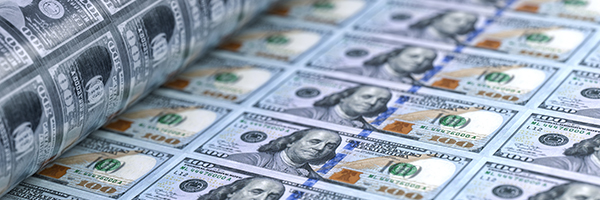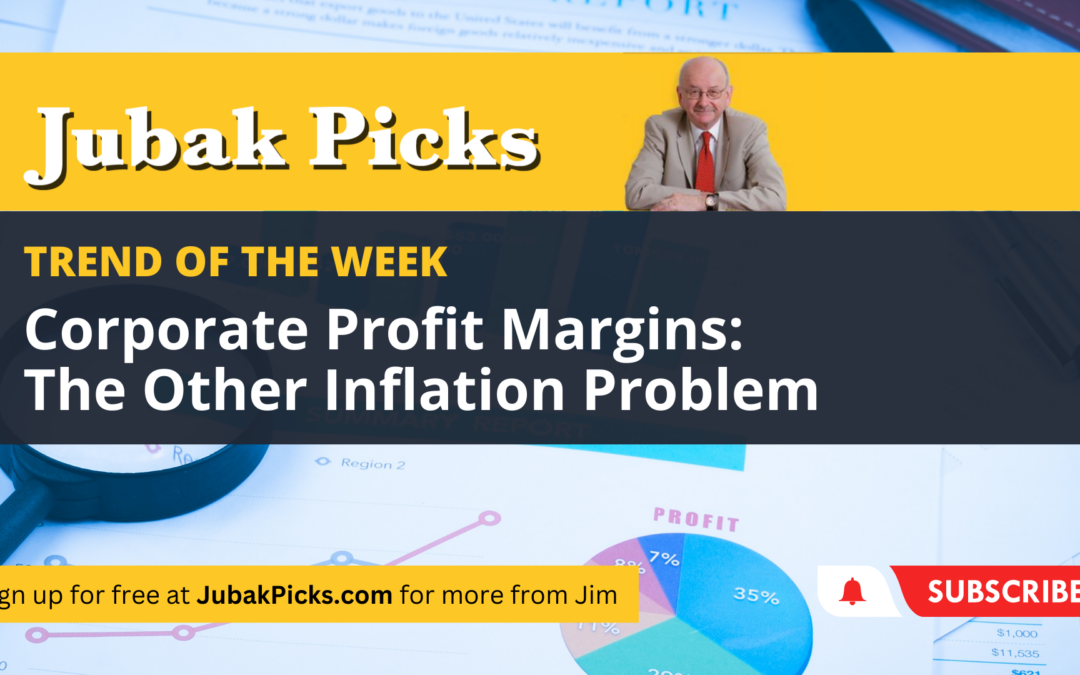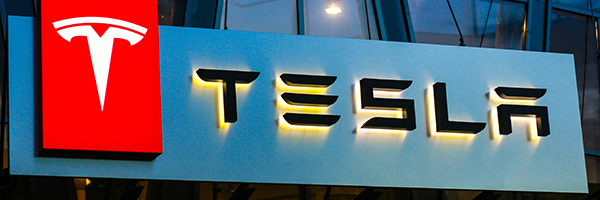
August 1, 2023 | Daily JAM, Morning Briefing |
The big problem, in my opinion, is that the today’s action by Fitch Rating won’t be the last ding to the U.S credit rating. It’s hard of me to see a quick turnaround in any of the negative trends that Fitch cited as a reason for lowering its rating on U.S. debt to AA+ from AAA.

July 31, 2023 | Daily JAM, Videos |
Today’s Trend of the Week: Corporate Profit Margins–The Other Inflation Problem. The market is currently unsure if the Fed will continue to raise rates in September and December. Complicating the Fed’s job of bringing inflation: The trend in corporate profits. Profit margins are projected at 11.1% for the second quarter, down from 11.5% in the first quarter and down from 12.2% in this quarter a year ago. The five year average is 11.4%. Six straight quarters of declining profit margins have companies looking for more ways to bring the margins back up. Any company that still has pricing power is likely to be raising prices. As an example, Spotify raised its U.S. subscription price to $10.99 a month from $9.99 a month- a reasonable, one-dollar increase that will defend the company’s profit margin. The Fed, of course, doesn’t want companies raise prices as the central bank tries to stem inflation by raising interest rates. However for the time being, companies are doing whatever they can to increase profit margins and that includes raising prices on things like toothpaste, if they can, much to the Fed’s chagrin.

July 27, 2023 | Daily JAM, Dividend Income, VZ |
Today’s Quick Pick is Verizon ( VZ). Verizon’s stock is up after recently reporting earnings. Verizon reported adjusted earnings of $1.21, up only 4 cents from the expected $1.17. The modest surprise was not what boosted the stock, however. Revenue was down year over year to $32.6 billion from $33.79 billion and the earnings were lower than last year’s $1.31 during this quarter. So why was there a bump in the stock? Verizon was expected to report a loss of 9,000 subscribers as competitors, like T-Mobile, chipped away at its customer base, but the company actually gained 8,000 postpaid subscribers. The stock has a great dividend of 7.68%, but the worry was, if Verizon continued to bleed subscribers, it would no longer be able to support the dividend. With the number of subscribers going up, that dividend looks to be safe and the stock will remain in my dividend portfolio on JubakPicks and JubakAM.

July 26, 2023 | Daily JAM, Morning Briefing |
The Federal Reserve raised its benchmark short-term interest rate 25 basis points to 5.25% to 5.50%. The central bank said that further interest rates are likely, but that the timing of any rate increases was contingent on data showing how the economy is reacting to interest rate increases so far. Fed Chair Jerome Powell made it clear that there is more work ahead to bring in inflation down to the Fed’s target of 2%. But he also made it clear that the timing of any future moves will depend on of data over the coming weeks and months. “We think we need to stay on task,” Powell said

July 26, 2023 | Daily JAM, Videos |
Today’s video is The Coming End of Business as Usual. One of the most extraordinary things about the global climate catastrophe is how little effect it’s had on financial markets and their behavior and expectations. The markets still believe that The Fed and other world central banks are still in control of the global economy. Increasing that’s not so as thousands of people die from the heat, places become more and more unlivable, and entire industries face stunning systemic changes. An example of such change is the homeowners market in Louisiana, Florida and California. Louisiana, after dealing with increasingly damaging hurricanes in recent years, has had a dozen insurers go belly-up in the state. Now, about 100,000 households have been forced to move from private insurers into the insurance state fund. Just like Florida, this fiscally conservative state is moving more and more of its citizens to a state-run insurance pool. Sixteen storms and hurricanes in the past three years have resulted in $100-200 billion of property damage in Florida, causing insurance rates to go up 200% since 2019 and many insurers to cease doing business the state. Now 1.4 million people rely on Florida’s Citizens Property Plan, a state-run fund. The conservative state has to rely on–dare I say it, socialism–in order to keep its real estate market goin-it’s hard to get a mortgage to buy a house without homeowners insurance. In California, wildfires have caused homeowners insurance policies to go up 16%, with many insurers leaving the state. The state’s insurance plan called “FAIR” has seen enrollment double since 2019. These are examples of the ways in which capitalism and capital markets will change during this age of global catastrophe. I think we can expect more to come.

July 25, 2023 | Daily JAM |
Yes, we do need more data before we can put a solid date on the collapse of the Atlantic Ocean’s circulation system that includes the Gulf Stream. But the fact that we’re asking that question is really, really scary. The last time the Atlantic circulation failed was during the Younger Dryas about 12,900 to 11,700 years before the present. The change was relatively sudden, taking place over decades (study of this period has overturned the idea that all climate change is slow), and resulted in a decline of temperatures in Greenland by 7 to 18 degrees Fahrenheit and advances of glaciers and drier conditions over much of the temperate Northern Hemisphere.

July 25, 2023 | Daily JAM, Morning Briefing, MSFT |
This isn’t the quarter I expect from a stock trading at a record, all-time high. Today, after the close, Microsoft (MSFT) reported fiscal fourth-quarter adjusted earnings of $2.69 a share. That exceeded Wall Street estimates of $2.55 a share.Revenue rose on 8% to $56.2 billion Wall Street analysts had expected $55.5 billion. For the fiscal 2023 year revenue grew by just 7%. That was the lowest annual growth since 2017.

July 25, 2023 | Daily JAM, DHR, Jubak Picks, Long Term, Top 50 Stocks |
The comparisons with 2022 continue to hurt shares of Danaher (DHR). For the second quarter, reported yesterday, the company saw revenue down 8% and adjusted earnings per share off 26% year over year. The culprit is easy to see. But I continue to hold Danaher in my Jubak Picks Portfolio where the position, initiated on June 20, 2017, was up 198.3% as of the close on July 25. Tomorrow July 26, I’ll be adding these shares to my long-term 50 Stocks portfolio. Danaher is one way to play the growth of the drug sector and the need of these companies for pure water.

July 24, 2023 | Daily JAM, Videos |
Today’s Trend of the Week is This is What Deflation Looks Like. Last week, Ford announced it’s cutting the price of the Ford F-150 electric truck, the F-150 Lightning, by nearly $10,000. The prices had gone up when supplies were low, but now, Ford says that they’ve cut production costs, so they’re able to cut prices. Maybe. That’s one explanation anyway. But, the news came as Tesla’s long-awaited truck appears to be finally hitting the market (sometime this year.) There is an over-supply of electric vehicles in general as more and more car makers have pivoted to the EV, and the sector hasn’t grown as fast as the production. In order to keep market share in a young-fast growing industry, companies, like Ford, will cut prices. This is as an early sign of a potential deflationary period. The timing of a transition from an inflationary environment to a deflationary environment will depend largely on global climate change. A lot of money will have to be spent on building, or rebuilding infrastructure, which could stress supply, putting the brakes on deflation. Keep an eye out for my special report called, Investing in Global Climate Catastrophe for more on inflation, deflation and interest rates. For now, the Ford announcement gives us the first hint of deflation in a critical sector of the global economy.

July 24, 2023 | Daily JAM, Morning Briefing |
Ho, hum, it’s a quiet week with nothing much going on. Oh, except for the meeting the Federal Reserve’s interest-rate setting Open Market Committee on Wednesday, July 26. Oh, and earnings from Microsoft (MSFT) and Alphabet (GOOG) on July 25, and Meta Platform (META aka Facebook) on July 26. Apple (AAPL) and Amazon (AMZN report on August 3.

July 21, 2023 | Daily JAM, Dividend Income, IRM, Jubak Picks |
Today’s Quick Pick is Iron Mountain (IRM). Iron Mountain has been around since the 1950s. It started off as a corporate document storage repository and has gradually moved into shredding, security and digitalization (they digitize and store important documents) and a full cloud storage and management offering. The company has 93 million square feet of storage around the world in 56 countries. It acquired about 29 companies in the last three years as the company looks to consolidate a still rather fragmented industry. It has had an average 5.6% revenue growth over the last three years. Morningstar calculates the shares trade at a 3% discount, with a PE of 31, and they pay a 4.2% dividend. I think Iron Mountain is riding a number of o-gern The long-term trends that include corporate and cyber security, as well as the need for document backup in a age of climate change. I’ll be adding this to my JubakPicks and Dividend portfolios on Monday, July 24..

July 20, 2023 | Daily JAM, Morning Briefing, TSLA |
Tesla (TSLA) delivered a big beat over Wall Street estimates when the company reported second quarter earnings after the close yesterday. The company reported earnings of 91 cents a share, well above the Wall Street projection of 80 cents a share. But in after hours trading, the stock still fell by 4.20%. Today, July 20, the shares are down 7.17% as of 10:45 a.m. New York time. And this comes despite another record quarter of unit sales. The problem?














